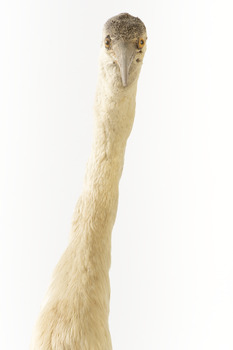Historical information
An Australasian Darter is a waterbird with a distinctive long straight neck and a sharp bill. This feature has resulted in this bird sometimes being called the "snakebird" . This specimen is a slim bird with pale grey to white colouring. This colouring identifies this particular specimen as female. The Australasian Darter is commonly located around waterways in freshwater or brackish wetlands more than 0.5m deep. The Darter will perch on fallen trees and branches near the water and holds its wings out to the sides in an effort to dry them. The Noongar people of southwestern Australia called this bird "mimal". It has also been called the New Holland darter or the New Holland devil-bird.
This specimen is part of a collection of almost 200 animal specimens that were originally acquired as skins from various institutions across Australia, including the Australian Museum and the National Museum of Victoria, as well as individuals such amateur anthropologist Reynell Eveleigh Johns between 1860-1880. These skins were then mounted by members of the Burke Museum Committee and put-on display in the formal space of the Museum’s original exhibition hall where they continue to be on display. This display of taxidermy mounts initially served to instruct visitors to the Burke Museum of the natural world around them, today it serves as an insight into the collecting habits of the 19th century.
Significance
This specimen is part of a significant and rare taxidermy mount collection in the Burke Museum. This collection is scientifically and culturally important for reminding us of how science continues to shape our understanding of the modern world. They demonstrate a capacity to hold evidence of how Australia’s fauna history existed in the past and are potentially important for future environmental research.
This collection continues to be on display in the Museum and has become a key part to interpreting the collecting habits of the 19th century.
Physical description
An Australasian Darter with a large, slim body and grey to white colouring. This specimen has a long snake-like neck and webbed feet. It has large powerful wings positioned flat against the rear of its body. The eyes are made of glass and are a pale yellow colour which is similar in colour to the long and sharp bill.
Inscriptions & markings
Paper label: "154 New Holland Darter"


























